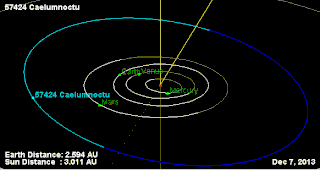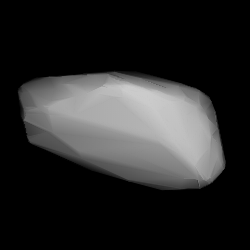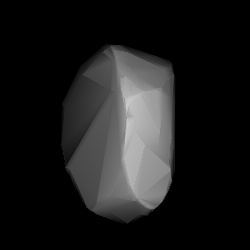Related Research Articles
51826 Kalpanachawla, provisional designation 2001 OB34, is an Eoan asteroid in the outer region of the asteroid belt, approximately 7 kilometers in diameter. It was discovered on 19 July 2001, by astronomers of the Near-Earth Asteroid Tracking program at Palomar Observatory in California, United States. The asteroid was named for Indo-American astronaut and mission specialist Kalpana Chawla, who died in the Space Shuttle Columbia disaster.

57424 Caelumnoctu, provisional designation 2001 SP22, is an Eoan asteroid from the outer regions of the asteroid belt, approximately 7 kilometers in diameter. It was discovered on 16 September 2001, by astronomers of the Lincoln Near-Earth Asteroid Research at Lincoln Laboratory's Experimental Test Site near Socorro, New Mexico. The asteroid was named for the BBC television programme The Sky at Night.
2531 Cambridge, provisional designation 1980 LD, is a stony Eoan asteroid from the outer regions of the asteroid belt, approximately 20 kilometers in diameter. It was discovered on 11 June 1980, by American astronomer Edward Bowell at Lowell's Anderson Mesa Station in Arizona, United States. The asteroid was named for the Cambridge University.
9916 Kibirev, provisional designation 1978 TR2, is a Koronian asteroid from the outer regions of the asteroid belt, approximately 6 kilometers (3.7 miles) in diameter. It was discovered on 3 October 1978, by astronomer Nikolai Chernykh at the Crimean Astrophysical Observatory in Nauchnij, on the Crimean peninsula. The likely S-type asteroid has a rotation period of about 15.2 hours and was named after Russian informatician Sergej Kibirev.
15092 Beegees, provisional designation 1999 EH5, is a stony Eoan asteroid from the outer regions of the asteroid belt, approximately 12 kilometers (7.5 miles) in diameter. It was discovered on 15 March 1999, by Australian amateur astronomer John Broughton at his Reedy Creek Observatory in Queensland, Australia. The S-type asteroid was named for the brothers of the Gibb family, known as the musical trio Bee Gees.
2325 Chernykh, provisional designation 1979 SP, is a dark Themistian asteroid from the outer regions of the asteroid belt, approximately 23 kilometers in diameter. It was discovered on 25 September 1979, by Czech astronomer Antonín Mrkos at the Klet Observatory in the Czech Republic. The asteroid was named after Russian astronomer couple Lyudmila Chernykh and Nikolai Chernykh.

4429 Chinmoy, provisional designation 1978 RJ2, is a Nysian asteroid from the inner regions of the asteroid belt, approximately 3.5 kilometers (2.2 miles) in diameter. It was discovered on 12 September 1978, by Soviet astronomer Nikolai Chernykh at the Crimean Astrophysical Observatory in Nauchnij, on the Crimean Peninsula. The likely S-type asteroid was named after Indian spiritual leader Sri Chinmoy.

6546 Kaye (prov. designation: 1987 DY4) is a dark and elongated background asteroid from the outer region of the asteroid belt. It was discovered on 24 February 1987, by Czech astronomer Antonín Mrkos at the South Bohemian Kleť Observatory in the Czech Republic. The presumed C-type asteroid has a rotation period of 10.0 hours and measures approximately 22 kilometers (14 miles) in diameter. It was named for American actor Danny Kaye.

1836 Komarov is a carbonaceous Dorian asteroid from the central region of the asteroid belt, approximately 22 kilometers in diameter. It was discovered on 26 July 1971 by Russian astronomer Nikolai Chernykh at Crimean Astrophysical Observatory in Nauchnij on the Crimean peninsula. It was named after Soviet cosmonaut Vladimir Komarov.
4944 Kozlovskij, provisional designation 1987 RP3, is a carbonaceous Witt asteroid from the central regions of the asteroid belt, approximately 10 kilometers (6 miles) in diameter. It was discovered on 2 September 1987, by Soviet astronomer Lyudmila Chernykh at the Crimean Astrophysical Observatory in Nauchnij, on the Crimean Peninsula. The asteroid was named for Russian opera singer Ivan Kozlovsky.
3322 Lidiya, provisional designation 1975 XY1, is a stony Phocaea asteroid and potentially slow rotator from the inner regions of the asteroid belt, approximately 7 kilometers in diameter. It was discovered on 1 December 1975, by Soviet astronomer Tamara Smirnova at the Crimean Astrophysical Observatory in Nauchnij, on the Crimean peninsula. The asteroid was named after Russian aviator Lidiya Zvereva.
1410 Margret, provisional designation 1937 AL, is an Eoan asteroid from the outer regions of the asteroid belt, approximately 21 kilometers in diameter. It was discovered on 8 January 1937, by astronomer Karl Reinmuth at the Heidelberg Observatory in southwest Germany. The asteroid was named after Margret Braun, wife of the Heidelberg astronomer Heinrich Vogt.
3074 Popov, provisional designation 1979 YE9, is a carbonaceous Nysian asteroid from the inner regions of the asteroid belt, approximately 10 kilometers (6 miles) in diameter. It was discovered on 24 December 1979, by Soviet–Russian astronomer Lyudmila Zhuravleva at the Crimean Astrophysical Observatory in Nauchnyj on the Crimean peninsula. The B-type asteroid has an unknown rotation period. It was named after Russian physicist Alexander Stepanovich Popov, an early radio pioneer in Russia.
8661 Ratzinger, provisional designation 1990 TA13, is an Eoan asteroid from the outer region of the asteroid belt, approximately 13.4 kilometers in diameter. It was discovered on 14 October 1990, by German astronomers Lutz Schmadel and Freimut Börngen at the Karl Schwarzschild Observatory in Tautenburg, eastern Germany. The asteroid was named after Cardinal Joseph Ratzinger, who became Pope Benedict XVI.

2111 Tselina is a stony Eos asteroid from the outer regions of the asteroid belt. It was discovered on 13 June 1969, by Soviet astronomer Tamara Smirnova at Crimean Astrophysical Observatory in Nauchnij, on the Crimean peninsula. The S-type asteroid has a rotation period of 6.6 hours and measures approximately 23 kilometers in diameter. It was later named after the Soviet Virgin Lands Campaign.
2752 Wu Chien-Shiung, provisional designation 1965 SP, is an Eoan asteroid from the outer regions of the asteroid belt, approximately 16 kilometers in diameter. It was discovered on 20 September 1965, by astronomers at Purple Mountain Observatory in Nanking, China. The asteroid has a long rotation period of 36.3 hours. It was named for Chinese-American nuclear physicist Chien-Shiung Wu.
5855 Yukitsuna, provisional designation 1992 UO2, is a stony Marian asteroid from the central regions of the asteroid belt, approximately 11 kilometers (7 miles) in diameter. It was discovered on 26 October 1992, by Japanese astronomers Akira Natori and Takeshi Urata at the JCPM Yakiimo Station. The likely elongated S-type asteroid has a rotation period of 19 hours. It was named for Minamoto no Yukitsuna, a Japanese general during the Heian era.
21873 Jindřichůvhradec, provisional designation 1999 UU3, is a dark Hygiean asteroid and relatively slower-than average rotator from the outer region of the asteroid belt, approximately 8 kilometers (5.0 miles) in diameter.
10140 Villon, provisional designation 1993 SX4, is a Nysian asteroid from the inner regions of the asteroid belt, approximately 5 kilometers (3 miles) in diameter. It was discovered on 19 September 1993, by Belgian astronomer Eric Elst at the CERGA Observatory at Caussols in France. It was named after 15th-century French poet François Villon.
3703 Volkonskaya, provisional designation 1978 PU3, is a Vestian asteroid and asynchronous binary system from the inner regions of the asteroid belt, approximately 4 kilometers (2.5 miles) in diameter. It was discovered on 9 August 1978, by Soviet astronomers Lyudmila Chernykh and Nikolai Chernykh at the Crimean Astrophysical Observatory in Nauchnij, on the Crimean peninsula. It was named by the discoverers after the Russian princess Mariya Volkonskaya. The V-type asteroid has a rotation period of 3.2 hours. The discovery of its 1.4-kilometer minor-planet moon was announced in December 2005.
References
- 1 2 3 4 5 6 "4118 Sveta (1982 TH3)". Minor Planet Center. Retrieved 10 April 2018.
- 1 2 3 4 5 "JPL Small-Body Database Browser: 4118 Sveta (1982 TH3)" (2017-06-05 last obs.). Jet Propulsion Laboratory . Retrieved 10 April 2018.
- 1 2 "Asteroid 4118 Sveta – Nesvorny HCM Asteroid Families V3.0". Small Bodies Data Ferret. Retrieved 27 October 2019.
- 1 2 3 Masiero, Joseph R.; Mainzer, A. K.; Grav, T.; Bauer, J. M.; Cutri, R. M.; Dailey, J.; et al. (November 2011). "Main Belt Asteroids with WISE/NEOWISE. I. Preliminary Albedos and Diameters". The Astrophysical Journal. 741 (2): 20. arXiv: 1109.4096 . Bibcode:2011ApJ...741...68M. doi:10.1088/0004-637X/741/2/68.
- 1 2 Nesvorný, D.; Broz, M.; Carruba, V. (December 2014). "Identification and Dynamical Properties of Asteroid Families". Asteroids IV. pp. 297–321. arXiv: 1502.01628 . Bibcode:2015aste.book..297N. doi:10.2458/azu_uapress_9780816532131-ch016. ISBN 9780816532131.
- ↑ "MPC/MPO/MPS Archive". Minor Planet Center. Retrieved 10 April 2018.
- ↑ "4303 Savitskij (1973 SZ3)". Minor Planet Center. Retrieved 10 April 2018.